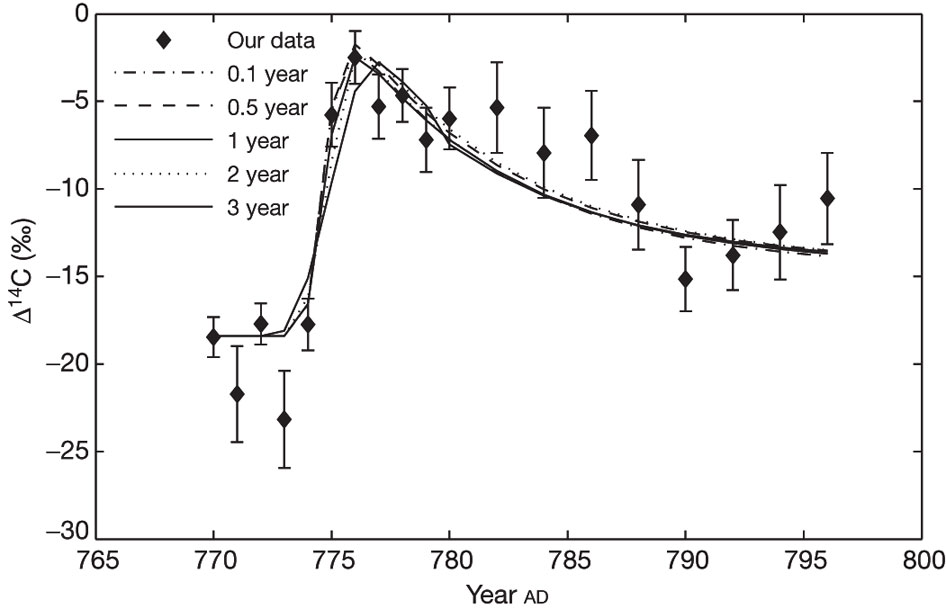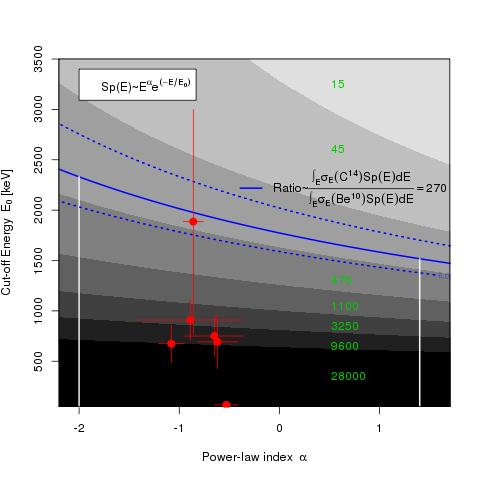A Galactic short Gamma-Ray-Burst
as cause for the 14C peak in AD 774/5 ?
 |
This is figure 2 from Miyake et al. (2012) showing the strong and short increase in 14C in the year AD 774/5 as observed by Miyake et al. Filled diamonds represent the Δ 14C values of the Miyake et al. data, and lines represent an expected change by a four-box carbon cycle simulation. Various lines represent different cosmic-ray input durations of 0.1, 0.5, 1, 2 and 3 years. The Δ 14C value of the simulation in AD 773 is fixed at a value calculated by the weighted average of the three data from AD 770 to 772. The figure shows the strong and short increase in 14C in the year AD 774/5 as observed by Miyake et al. | |
 |
This figure is from Hambaryan & Neuhäuser (2013): The figure shows that the typical spectra of short Gamma-Ray-Bursts are fully consistent with the differential 14C to 10Be production rate (at least 270 ± 140) as observed in the AD 774/5 event. Given the typical energy spectrum of a short GRB with a power-law index α = -2 to 1.4 (vertical black lines) and a cutoff energy E0 = 49 to 1900 keV and also given the cross-sections of the reactions 14N(n,p)14C and 14N(n,p+α)10Be from 10 to 60 MeV, we estimated the expected fraction for a grid of alpha and E0. The observed lower limit on this fraction is shown as blue curve with dotted lines as error margin. The green numbers in the different grey shaded areas indicate the ratio of 14C to 10Be production from low values in the upper right to high values in the lower left. We also show the observed power-law indices and cutoff energies of all six short GRBs with known redshifts as red dots with vertical and horizontal red 1 σ error bars. Because the power-law index and the cutoff energy needed to reproduce the observed lower limit of 270 ± 140 lies in the typical range of short GRBs and because all data points of local short GRBs lie on or below the line for 270 ± 140, the observed production ratio of 14C to 10Be in AD 774/5 is well consistent with a typical short GRB. It is not consistent with a supernova nor a long gamma-ray burst nor a solar nor stellar flare. | |
Remark on the "red cross or crucifix after sunset"Allen (2012, Nature 486, 473) connected the Anglo-Saxon Chronicle quote (“red crucifix, after sunset”) to a possibly absorbed, reddened supernova in AD774/5 (Miyake et al. 2012, Nature 486, 473), clearly wrong: A supernova is observed as extended object only within few parsec. Then, an extinction event on Earth and a supernova remnant detectable in X-rays behind strong absorption are expected, both are excluded. Allen's quotation is dated AD774 in some of seven chronicle versions, but dated AD776 or 773 in others (Whitelock, 1979, English Historical Documents, Oxford Univ. Press). It is linked to the “Battle at Otford” in AD776 (Gibbons & Werner, 2012, Nature 487, 432). Newton (1972, Medival Chronicles, Hopkins Univ. Press) presents six sightings of a “cross” from AD776 to 1208. The phenomenon is caused by reflecting floating ice crystal plates creating halos around the Sun (parhelion), sometimes with apparent additional mock suns, mostly near horizon, i.e. redish; a vertical pillar of light above the sun is created by slowly falling ice flakes reflecting sunlight; all similar for the moon (paraselene). “When a vertical pillar and a part of the horizontal circle occur at the same time, we see a cross in the sky. Needless to say, the superstitious have made the most of it” (Minnaert, 1993, Light and color in the outdoors, Springer). The reason for many such sightings in chronicles of monasteries lies in the christian-apocalyptic zeitgeist: Patristic chiliasm/millennialism combined Bible quotes (Gen 1,31-2,3; Ps 90,4; Rev 20,1-5) to conclude that a 1000-year-long messianic kingdom would start 6000 years after the presumable creation indicated by portents: “The sign of the Son of Man will appear in heaven” (Jesus in Mt 24,30); “making peace through the blood of his cross” (Col 1,20). Assuming that the sign of Jesus is the cross, any sighting of a (red) cross was mis-interpreted as presumable start of the last millennium. This is a short summary of a more extended paper by Neuhäuser & Neuhäuser to be submitted soon. |
||
